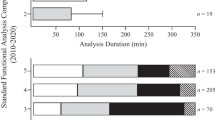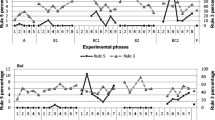Abstract
No research has used latency-based functional analysis (FA) outcomes as baseline data from which to evaluate the effectiveness of subsequent function-based treatments. This approach to analysis calls for the continued collection of latency-based measures for all targeted variables throughout all phases of treatment. We tracked client progress during treatment using latency-based, rate-based, and percentage-of-opportunity measures of relevant behavior and compared graphical representations of each. Visual inspection of all data indicates that changes in variability level and trend of latency-based measures correspond well with said changes in more traditional measures.

Similar content being viewed by others
References
Baker, J. C., Hanley, G. P., & Mathews, R. M. (2006). Staff-administered functional analysis and treatment of aggression by an elder with dementia. Journal of Applied Behavior Analysis, 39, 469–474. doi:10.1901/jaba. 2006.80-05.
Carr, E. G., & Durand, V. M. (1985). Reducing behavior problems through functional communication training. Journal of Applied Behavior Analysis, 18, 111–126. doi:10.1901/jaba. 1985.18-111.
Fisher, W. W., Kuhn, D. E., & Thompson, R. H. (1998). Establishing discriminative control of responding using functional and alternative reinforcers during functional communication training. Journal of Applied Behavior Analysis, 31, 543–560. doi:10.1901/jaba. 1998.31-543.
Hanley, G. P., Iwata, B. A., & Thompson, R. H. (2001). Reinforcement schedule thinning following treatment with functional communication training. Journal of Applied Behavior Analysis, 34, 17–38. doi:10.1901/jaba. 2001.34-17.
Iwata, B. A., Dorsey, M. F., Slifer, K. J., Baumen, K. E., & Richman, G. S. (1982/1994). Towards a functional analysis of self-injury. Journal of Applied Behavior Analysis, 27, 197-209. doi:10.1901/jaba.1994.27-197.
Kahng, S. W., & Iwata, B. A. (1998). Play versus alone conditions as controls during functional analyses of self-injurious escape behavior. Journal of Applied Behavior Analysis, 31, 669–672. doi:10.1901/jaba. 1998.31-669.
Lambert, J. L., Doyle, A. M., Barrows, S. B., & Houchins-Juarez, N. J. (submitted for publication). Two variations of traditional FA methodology for assessing the function of noncompliance: with treatment evaluation. Journal of Applied Behavior Analysis.
Laraway, S., Snycerski, S., Michael, J., & Poling, A. (2003). Motivating operations and terms to describe them: some further refinements. Journal of Applied Behavior Analysis, 36, 407–414. doi:10.1901/jaba. 2003.36-407.
Lloyd, B. P., Wehby, J. H., Weaver, E. S., Goldman, S. E., Harvey, M. N., & Sherlock, D. R. (2014). Implementation and validation of trial-based functional analyses in public elementary school settings. Journal of Behavioral Education. doi:10.1007/s10864-014-9217-5.
Thomason-Sassi, J., Iwata, B. A., Neidert, P. L., & Roscoe, E. M. (2011). Response latency as an index of response strength during functional analyses of problem behavior. Journal of Applied Behavior Analysis, 44, 51–67. doi:10.1901/jaba. 2011.44-51.
Acknowledgments
We would like to thank Gounah Choi and Destiney Young for their assistance with the conceptualization and implementation of this project. We also thank the Treatment and Research Institute for Autism Spectrum Disorders (TRIAD) for providing clinic space.
Compliance with Ethical Standards
This manuscript is not under review, nor has it been published, elsewhere. This submission has been approved by all authors and by the responsible authorities where the work was carried out. The participant’s guardian provided informed consent for her daughter’s participation in this study before we initiated study-related activities.
Author information
Authors and Affiliations
Corresponding author
Additional information
Implications for Practitioners
• Decrease probability of high rates of problem behavior during assessment
• Potentially decrease caregiver objection to pretreatment activities
• Increase efficiency of service delivery
• Decrease effort of meaningful data collection
Rights and permissions
About this article
Cite this article
Caruthers, C.E., Lambert, J.M., Chazin, K.M. et al. Latency-Based FA as Baseline for Subsequent Treatment Evaluation. Behav Analysis Practice 8, 48–51 (2015). https://doi.org/10.1007/s40617-015-0046-3
Published:
Issue Date:
DOI: https://doi.org/10.1007/s40617-015-0046-3




